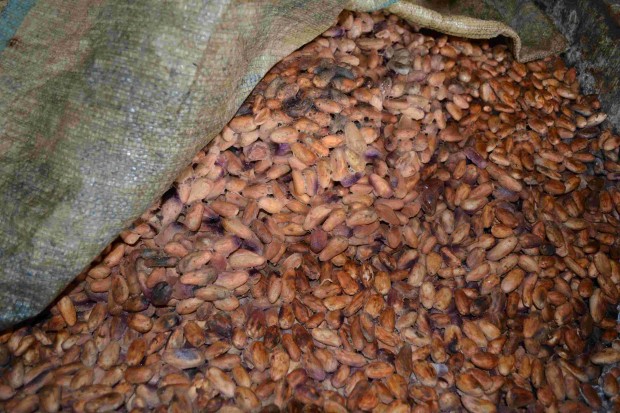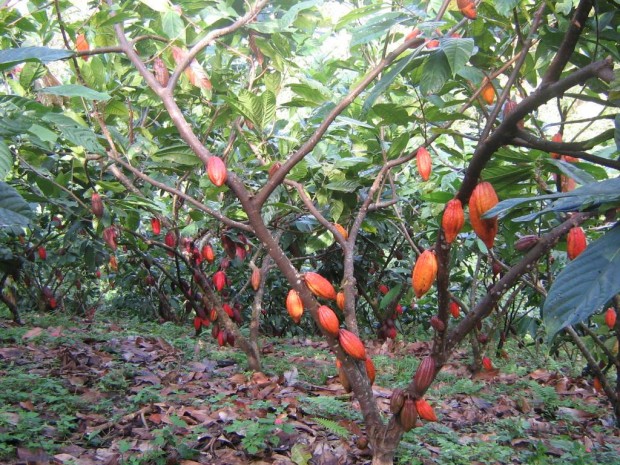- No products in the cart.
Our Cacao
Types of Cacao:
When most people think of chocolate they are referring to “Bulk beans” which come from the Forastero variety of cacao and make up 90% of the World’s chocolate market. Forastero beans have a less complex flavor, but is robust in the tones that are present. “Flavor beans” are derived from Criollo and Trinitario (a mix of Criollo and Forastero) varieties. These beans carry a wide range of complex flavors, but milder tones so they are used in fine chocolate bars that can be found in boutique confectioneries or gourmet shops. We use Criollo beans for our hot chocolate cubes.
The Region
Our Cacao grows high in the Andes Mountains, in the Santander region of Colombia. This region has a complex topography and rich volcanic soils, allowing farmers to sometimes cultivate cacao alongside coffee plants in similar Bosque-style farms. Shading, fruit trees and promotion of small growing ecosystems create unique fruity tones in the cacao and promotes an exceptional aroma.
The People
Here, cacao is grown in small family farms and is cultivated with the help of generations of experience and the communities that support them. Local harvests begin by picking the pods by hand and using ragged machetes and dull knives to separate the beans from the hull. Experienced farmers quicken their process by slicing around the fruit so that the stem and collection of beans slide out of the cup-shaped hull. After harvesting the pods they move the beans, still covered in their original white gooey covering, to long wood boxes to begin the fermentation processes.
Many Delicious Things Are Fermented
We know that sounds weird but it’s true. Cacao is just one more on list of superstar foods like Cheese, Kimchi, and Yogurt. Once transferred into in the wooden boxes microorganisms in the air begin to ferment the inner bean. The sugar outside (in this deliciously gooey mess) provides the sugars required for the germination process and it continues until all of the pulp is dissolved and only the bean remains.
The benefits of Fermentation are significant. The cacao bean acids are naturally removed, and if fermentation isn’t rushed, later processing can skip several chemicals that are used to patch up shoddy cultivation/practices. During the fermentation process beans develop their flavor due to factors such as the quality of soil, surrounding foliage, and growing conditions.
Fermentation is the part of the development process in creating chocolate that regulates harshness/bitterness. The sugars in the gooey white mucilage that covers the beans turn into acetic acid and as the temperature rises the acids penetrate into the beans, creating biochemical reactions that instill the precursors to the flavor that will later be activated by the roasting process.
Criollo beans being naturally milder, often showcasing floral and fruitful tones, require much shorter fermentation times than bulk beans.
Final Steps:
The beans are then spread out underneath the sun for several days to lower the water content in the bean from 50% to about 7%, making it ready for sale to processors. Cacao is gently roasted in processing plants organized by the Federation of Cacao growers. Here, the flavor and aroma fully mature. The roasting process for cacao begins at 210F and tops out at 310F (instead of 380-480F for coffee roasting). It can become very stressful because the cacao is extremely sensitive to temperature variations. If it is a degree or two in either direction or a few seconds too long or too short, the entire batch can be ruined.
The Optional Step:
Finally, the chocolate process is finalized with the addition of chemicals like emulsifiers and other additives that either “cleanup” bad processing or contribute to shelf-life. Making fine chocolate requires a significant amount of care, costs in labor, and attention to detail that this part of production allows to shortcut. This includes emulsifiers like soy lecithin to alter texture and to make the oil in the cacao mix with water. Our cubes completely avoid the use of any chemicals in the production process. Instead of soy lecithin, we use Panela (raw, unrefined cane sugar) to hold our cubes together.




